How to Write Documentation: A Comprehensive Guide for 2025
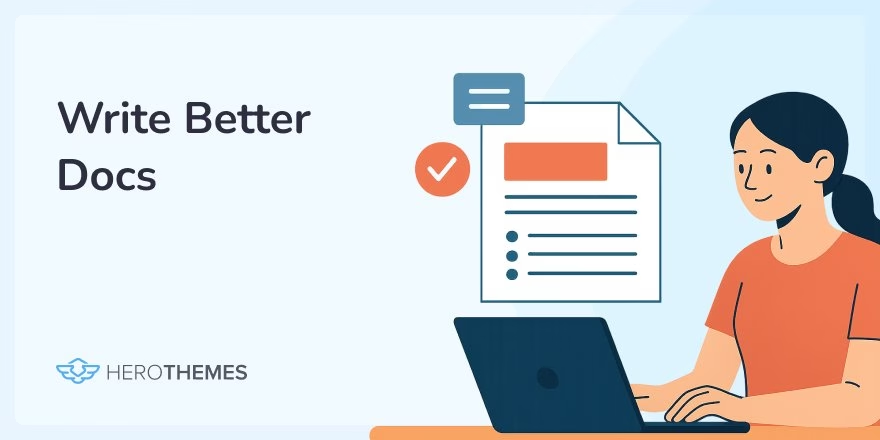
Your life can be so much easier once you know how to write documentation—good, helpful documentation that actually gives its users what they need from it.
After all, every team needs documentation to share information, retain knowledge, stay focused on goals, and simplify long processes.
While there’s no one standard way to create all this documentation, the fundamentals remain the same.
Let’s take a look at them to improve your documentation writing skills.
In This Guide
- The State of Documentation Writing in 2025
- What Is Documentation
- Types of documentation you need to know before writing it
- Why Good Documentation Is So Important (Benefits and Impact)
- What Does Good Documentation Look Like?
- How to Write Documentation That Truly Helps
- 1. Decide What to Write
- 2. Start with an Outline
- 3. Write in Small, Manageable Pieces
- 4. Use a Conversational Tone (for appropriate audiences)
- 5. Don’t Be Afraid to Show Personality (a Little)
- 6. Keep Paragraphs and Sentences Short
- 7. Make it Scannable
- 8. Review and Test Your Docs
- 9. Set an Update Schedule
- 10. Use Metrics to Improve
- Choose the Right Tools and Software for Documentation

We rigorously test and research every product that we recommend through HeroThemes. Our review process. We may also earn a commission if you make a purchase through our links.
The State of Documentation Writing in 2025
Since the AI revolution Most brands are starting to use AI chat assistants to improve their customer experience on documentation.
It definitely helping with:
- Answering frequent questions and in a faster way
- Helping with the search
- Reducing customer tickets
- Personalizing the customer experience
- And of course, writing documentation
That said, you might wonder, “Can’t we just let ChatGPT write our docs?” Well, not so fast.
AI-generated text tends to be generic and lacks the nuanced context or opinionated clarity that human-written docs provide, which can easily backfire.
High-quality documentation requires deep understanding of context and thoughtful decisions—things AI struggles with.
Documentation is the process of figuring out what your users need and the best way to explain it. Skipping this step can result in content that doesn’t actually help anyone.
The sweet spot is using AI as a helper, not a replacement.
What Is Documentation
Documentation is any material that explains or instructs. It can be text, images, even videos. Anything that helps someone understand something or get something done.
We often think of software manuals or developer docs, but documentation is everywhere in business:
- Marketing team has playbooks
- Support team has troubleshooting guides and FAQs
- Engineers have code comments and technical specs
- HR has process checklists
- Customers rely on user guides and knowledge base articles
The key point here is that documentation is a broad umbrella. If its information written down (or recorded) to help someone else do something or understand something, it counts as documentation.
Types of documentation you need to know before writing it
Since we’re talking about writing documentation, I won’t bore you with the different types, such as project documentation, technical documentation, and so on.
Instead, In his talk on the types of documentation, Daniele Procida or Divio AG categorizes documentation into four types::
- learning-oriented tutorials
- goal-oriented how-to guides
- understanding-oriented discussions
- information-oriented reference material
As you can understand from how he puts it, every piece of documentation has a different objective, and those responsible for the documentation must establish it each time they set out to create one.
Based on the different types of documentation shared above, you can create documentation that easily fulfills its objective.
- Knowledge base articles: Short how-to articles or FAQs on a help center. Great for customers seeking quick answers.
- User manuals and guides: Longer form documentation explaining features, often with screenshots and step-by-step instructions.
Explore: Best User Manual Examples to Learn From - Technical reference docs: Detailed info on APIs, SDKs, configuration, primarily for developers or IT professionals.
- Project documentation: Records of project plans, decisions, research, and progress (for internal team use).
- Process and policy manuals: Standard operating procedures, company policies, checklists for internal workflows that ensure consistency in how things are done.
- Code documentation: This includes inline code comments, README files in repositories, and auto-generated docs from code (like Javadoc or Swagger for APIs).
- Design docs and specs: Documents created during development to describe how a feature should work or how a system is designed.
From this you can easily guess how different types of documents should be written.
For example, user manuals would focus on goal-oriented, how-to guides, while design documents would focus on information-oriented reference material.
Why Good Documentation Is So Important (Benefits and Impact)
Good documentation pays off massively, often in ways that aren’t immediately obvious.
Below are some of the major benefits of quality documentation:
1. Saves Time and Money by Enabling Self-Service
Perhaps the most direct benefit is that documentation lets people help themselves instead of creating support tickets for every single query.
A knowledge base can easily answer the most common questions about your product or service, eliminating the need to reach out to a support agent.
This translates to real money: fewer support tickets mean lower support costs and faster response for the tickets that do come in.
2. Drives Product Adoption and Customer Success
When users understand your product better, they use it more and derive more value from it. If that’s the case, they’re more likely to stick around (higher retention) and even advocate for it.
Docs offer immediate value by showing people how to achieve something with your product, whereas marketing might just tell them about features.
3. Faster Onboarding and Training
Having solid documentation makes it much easier to bring new people up to speed.
For customers, a good “Getting Started Guide” can make the difference between them abandoning the trial versus becoming a power user.
New employees or developers joining a project can read the documentation to get context. Which is much better than tedious training sessions or bothering a teammate every 5 minutes with questions.
5. Fewer Errors and Faster Troubleshooting
When instructions are clear and knowledge is shared, people are less likely to do the wrong thing.
6. Consistency and Knowledge Preservation
People come and go, but documentation sticks around.
By writing things down, you decentralize knowledge and avoid single points of failure.
7. An Asset for Scale and Growth
Think long-term. If you ever want your project or product to scale, you personally cannot be the answer to every question.
Documentation is what allows you to grow beyond heroics and one-on-one hand-holding. It’s a force multiplier.
What Does Good Documentation Look Like?
In the past, we have reviewed hundreds of documentation examples, and even the best ones were missing something.
This is just a quick recap of it, I recommend that you check out the guide on the best documentation examples yourself.
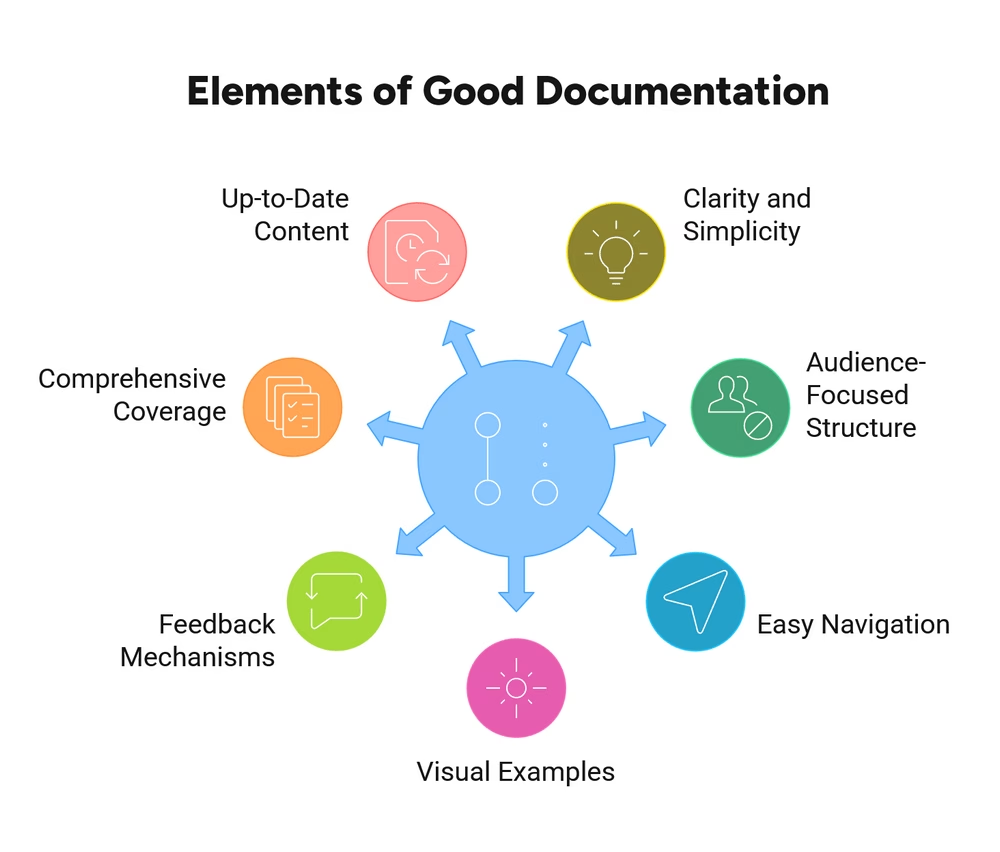
- Clarity and Simplicity: Good documentation speaks plain language. It’s as short as it can be while still being useful.
- Know Your Audience (and Organize for Them): The best documentation is structured around the user’s needs and knowledge level. One size does not fit all.
- Great Navigation and Search: Good docs are easy to navigate. Having a search bar, a logical hierarchy of topics, and a table of contents helps a lot.
- Plenty of Examples and Visuals: Good documentation is concrete. It provides examples. These examples can be sample code, screenshots, or real-world scenarios.
- Feedback Mechanisms: Documentation evolves based on user feedback. Without feedback, you’re shooting arrows in the dark.
- Comprehensiveness with Accessibility: Here comprehensive doesn’t mean writing a 500-page tome. It means covering the necessary ground so users don’t hit dead-ends.
- Freshness (Up-to-date)
Here’s a concise table comparing the key qualities of Good vs. Bad Documentation:
| Aspect | Good Documentation | Bad Documentation |
|---|---|---|
| Audience Focus | Written for a clear, specific audience (e,g. customers, developers), and content matches their needs and context | No defined audience; mixes levels of detail |
| Clarity & Language | Simple, direct, jargon-free, which is easy to read and understand | Full of jargon, run-on sentences, ambiguity, or excessive brevity/verbosity |
| Organization | Logical structure, clear headings, table of contents, cross-links, and prioritized information | Disorganized walls of text, missing navigation aids, important steps buried or scattered |
| Accuracy & Currency | Correct, tested, and regularly updated | Outdated instructions, wrong details, old screenshots |
| Depth vs. Brevity | Enough detail to accomplish tasks, with optional links for more | Too shallow with missing key steps, or overly deep with irrelevant minutiae |
| Examples & Visuals | Includes accurate, tested code samples, screenshots, and diagrams explained in context. | Few or no examples, outdated or unreferenced visuals, untested code snippets. |
| Tone & Empathy | Warm, supportive, and instructive | Condescending, overly formal, or impersonal |
| Searchability | Uses product terminology and common keywords. Easily indexed for internal and external search | Poor keyword choices, hidden in non-searchable formats, and mismatched terminology |
How to Write Documentation That Truly Helps
We’ve covered a lot of ground to get you prepared for this step. Now, let’s cover some practical steps and mindset tips as you embark on writing documentation:
1. Decide What to Write
Because documentation can take so many forms, it’s essential to finalize a format before writing it.
For example, at HeroThemes, we use a mix of FAQs, installation tutorials, troubleshooting guides, lists of tips and tricks, and others for our customer-facing documentation. Most of our customers also use a similar composition.
Depending on the documentation you’re producing and for whom, you’ll need to know what all forms your documentation can take.
Jacob Kaplan-Moss talks in detail about these in What to write.
He explains how tutorials, topical guides, and reference material make up the bulk of documentation in most cases:
- Tutorials: Tutorials or how-tos are the most basic form of documentation. For our customer-facing documentation, tutorials are our how-to resources that our users use to add a knowledge base to their website with our plugin or populate it with articles.
- Topical guides: Topical guides tend to go a lot deeper than tutorials and cater to more specialized topics. For us, these are our guides on topics like translation and integrations. We loosely categorize these as advanced topics.
- Reference: In our customer-facing documentation context, this type has information on our integrations with our partners that our users might find helpful when setting up their integrations. Or links to any stuff they might find useful when implementing any of our HeroThemes solutions.
2. Start with an Outline
Just as you design a product (or work on a plan before starting a new project) before building it, design your documentation.
Jot down an outline or table of contents of what you plan to cover.
This helps ensure that you include all the necessary topics and organize them logically. It also serves as a skeletal structure to fill in.
To give you a better idea of what this looks like, here’s how most software README files are designed:
- Quick product introduction
- Glossary to explain complex terminology
- Installation guide (Step-by-step)
- Basic Usage (With some examples)
- Frequently asked questions
Outlining also makes it easier to divide writing tasks among multiple contributors.
Here’s an outline template that I often use before writing any type of article or a guide.

3. Write in Small, Manageable Pieces
Tackle one article or section at a time. Perhaps start with a quick-start guide to help new users get started. Then expand into deeper reference material.
This incremental approach means you always have some useful docs even if the whole set isn’t complete yet.
4. Use a Conversational Tone (for appropriate audiences)
In general, I recommend using a friendly, conversational tone for user documentation and a straightforward, slightly more technical tone for developer documentation.
But never a robotic or patronizing tone.
Phrases like “now you’re ready to…”, “you might be wondering…” can make the text more engaging.
Being conversational also means anticipating questions.
5. Don’t Be Afraid to Show Personality (a Little)
If your brand voice allows, you can add small touches of personality, such as a light joke, an anecdote, or a tongue-in-cheek “Note:”
I once added a line in a troubleshooting doc: “If all else fails, try turning it off and on again—no, really 🙃.” Surprisingly, we got feedback that it made the doc more approachable.
Of course, use humor or personality sparingly and appropriately. The goal isn’t to entertain, but to make the experience less drudgerous.
6. Keep Paragraphs and Sentences Short
This is a simple writing hack for readability. Aim for paragraphs of 2-5 sentences.
In technical writing, clarity trumps literary flair. It’s perfectly fine to have a one-sentence paragraph if it contains a key point.
Also, use formatting to break things up:
- Bullet lists (like this one!)
- Numbered steps for procedures
- Tables for structured information
7. Make it Scannable
Most readers scan before they commit to reading.
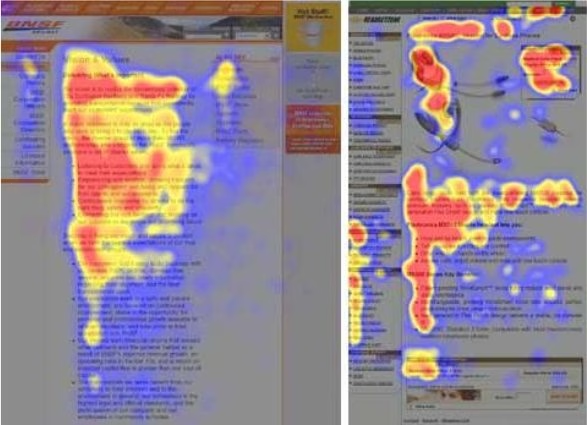
- Use clear headings and subheadings that signal what each section is about
- Use bold text to highlight important terms or keywords
- Use call-out blocks for tips/warnings
A scannable doc means even if the user doesn’t read every word, they can still extract the steps or info they need by glancing.
8. Review and Test Your Docs
Reviewing is an essential part of the documentation process. It helps you ensure that your documentation actually works.
In his five-step documentation reviewing process, technical writer Tom Johnson says that the first stage is unmissable where you — the documentation writer — make “the product work” for yourself following the steps you’ve written.
Take the time to follow your own instructions as if you’re the user. This is the only way to catch missing steps or assumptions.
If possible, also do a peer review: another person (ideally similar profile to your intended reader) goes through it and gives feedback. They’ll point out confusing bits or typos you overlooked.
9. Set an Update Schedule
Documentation starts stalling as soon as it’s published. So you need an update schedule.
Your update frequency will depend on the documentation you’re looking at. For instance, your user-facing documentation will need updates only when you update your product.
Developer-facing documentation, and technical code documentation is forever ongoing (inline documentation).
Your internal work documentation, on the other hand, could use updating each time something changes.
For example, when you replace your current project management tool or even when you simply discover a more optimized way of doing some work. Tribal knowledge capturing and general knowledge capturing are some of the ongoing exercises in such documentation.
When it makes sense, maintain a change log in your documentation so that users don’t feel lost when they see an updated version.
Also, as part of updating your documentation, get rid of the obsolete and duplicate files. A search in your documentation should never return multiple versions of the same support content. Each topic should only take one resource.
10. Use Metrics to Improve
Use analytics to identify content gaps in your documentation and improve its overall quality.
- If an article has a high “no” in helpfulness, rework it.
- If certain search terms are trending, maybe create an article for that.
- If a forum thread or support ticket pattern emerges on a topic not covered in docs, document it.
Over time, your documentation becomes more robust and self-correcting through these feedback loops.
Remember, outdated docs can be worse than no docs, because they mislead.
Additionally, here are some writing tips to help improve the quality of your content:
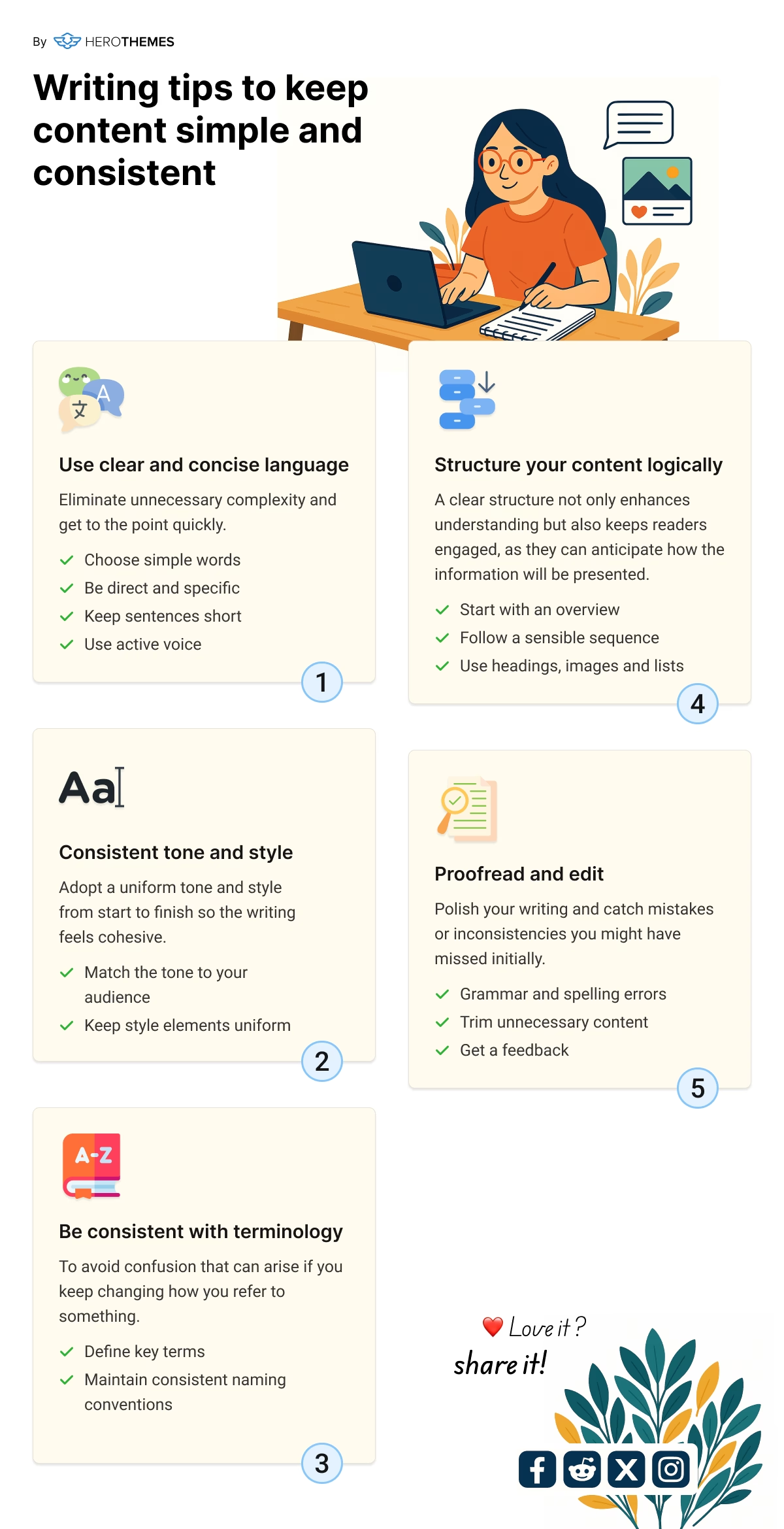
Choose the Right Tools and Software for Documentation
Writing documentation isn’t just about the content; it’s also about where that content lives and how it’s delivered.
The tools or platform you use can make documentation easier to produce and more useful to consume.
Heroic Knowledge Base
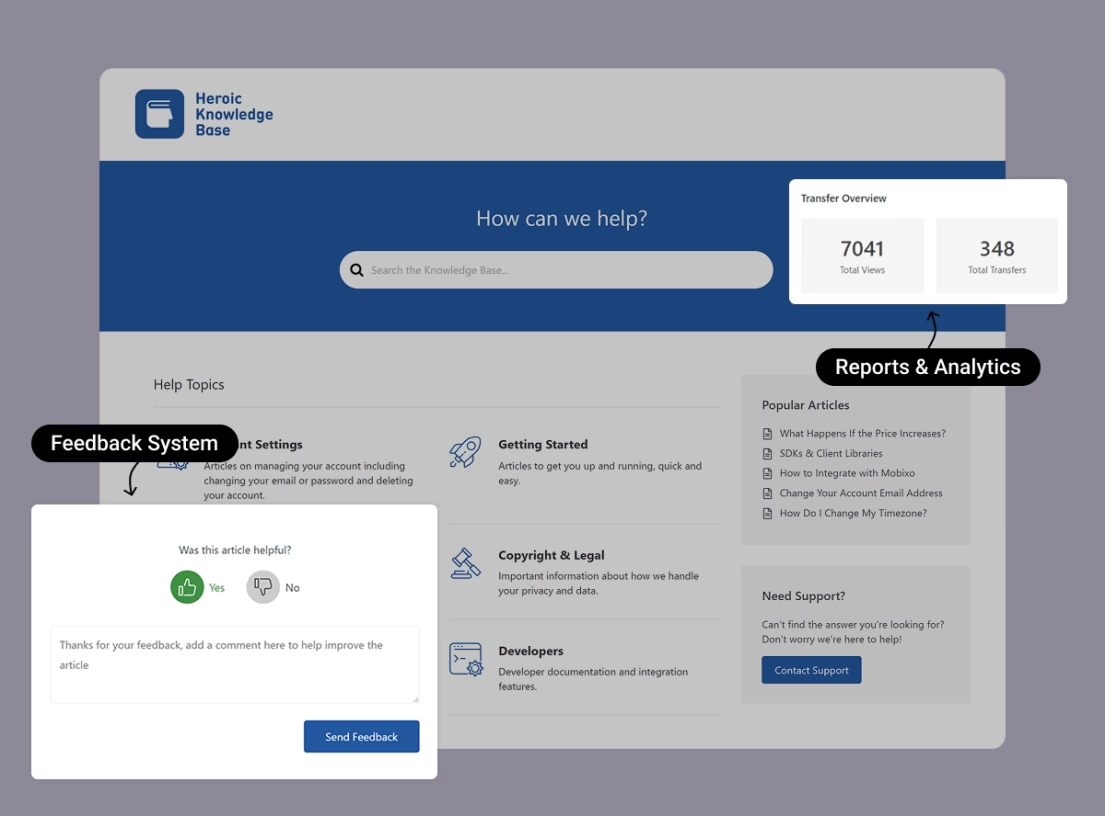
If you’re documenting a product for end-users or customers, a knowledge base is ideal.
These are usually web-based portals with search, categories, and article pages.
A great option here is Heroic Knowledge Base. A plugin that lets you create a full-featured knowledge base site on WordPress.
Key Features:
- Easy to setup with built-in setup wizard
- Freedom with article layouts and customization
- Instant search suggestions
- Article feedback system, reports, and analytics
- ChatGPT based AI virtual assistant
- Fully customizable portal
- Content restriction feature to create internal knowledge base
There are also tons of other helpful features.
The best thing about the Heroic Knowledge Base is that it’s very affordable. The base plan starts at just $67 per year!
Furthermore, I recommend checking out the guide on the 13 best technical writing tools and software.
Wrapping it up
Documentation writing is a craft and an ongoing journey. What you write today will evolve tomorrow, and that’s exactly how it should be.
Start with a solid foundation using the principles and practices we discussed.
Over time, iterate and improve.
Stay attuned to your readers and the shifting context of your product or project. When you adapt your writing to meet real user needs, your documentation remains a living resource that informs, guides, and delights.
Further Reading
7 Free and Premium Documentation Website Templates
Instruction Manual: What It is and Types
Software User Manual Examples and Template
Product Documentation: Everything You Need to Know
5 Best User Documentation Examples (Good & Bad + Tips)
How to Write a Getting Started Guide: The Beginners Guide!
Documentation Writer: Complete Role Breakdown (Skills, Salary and FAQs)



